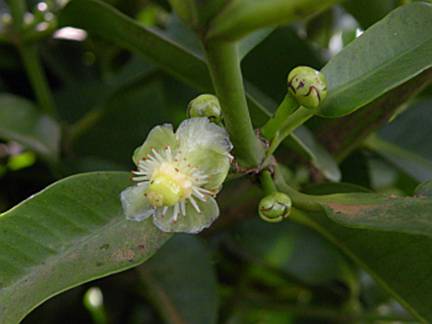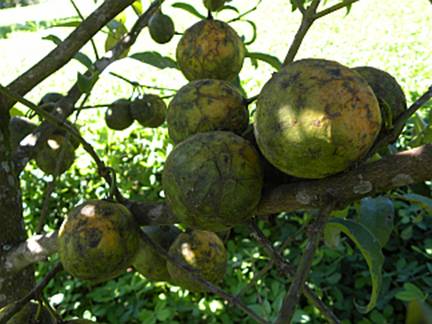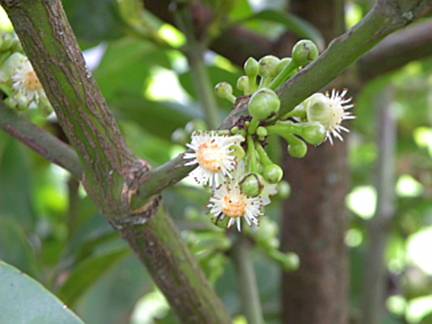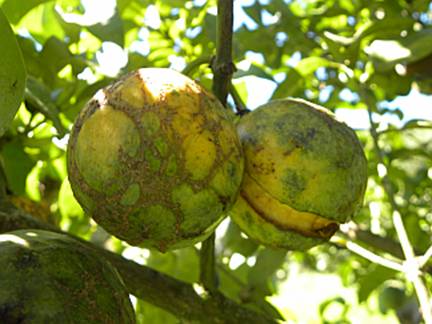GARCINIA MACROPHYLLA
FAMILIY OF CLUSIACEAE
|
|
|
|
Female flowers |
Mature fruits |
|
|
|
|
Male flowers |
Fruits and pulp |
NATIVE NAME: IBACURU comes from the Tupi-Guarani and means "Fruit ribbed or full of hardship" and notorious fact that the shell of the fruit is full of veins. Also called as Bacuri da Mata Atlântica, Bacurírana and Bacuru-pari.
Origin: Found in the remains of the Atlantic Forest and Caatinga in damp places in the northeast, where it is found in the states of Ceará, Pernambuco and Bahia in northern Brazil. More informations in the Portuguese language under the link: http://floradobrasil.jbrj.gov.br/2012/index?mode=sv&group=Root_.Angiospermas_&family=Root_.Angiospermas_.Clusiaceae_LINDL&genus=Garcinia+&species=&author=&common=&occurs=1®ion=&state=&phyto=&endemic=&origin=&vegetation=&last_level=subspecies&listopt=1
NOTICES: This species has been and is still mistakenly used by many authors of botanical books with the botanical name of this species for the Bacuri-Pari (Garcinia benthamiana), this differs by fruits with a conical tip.
FEATURES:
Culture tips: It is suitable for many different soil types and climates, and therefore can be grown throughout the Brazilian territory. Prefers average temperatures of 16° to 32°C for a good harvest of fruit. In our nursery many have adapted and have proven to be hardy to -2°C and tolerate drought to 5 months. Can be grown on loamy or sandy soils or red soil with fertility (clay or oxisols) with rapid drainage, this should have a pH from 5.5 to 7.0, the ideal level of pH 6.0 for the commercial crop production and sweetest fruit. The rainfall should be well distributed 1000-2000 m per year. Begins to bear fruit 4-5 years after planting.
Propagation: The seeds are oblong and large, the germination capacity can be maintained up to 4 months if the storage is clean, dry and dark. But it should sow one seed per bag of 17-21 cm, the pulp must be removed from the seeds Seed germination occurs in the substrate with 50% soil and 50% organic matter deposited. The seeds germinate in 60-120 days, the germination rate is 90%. Place the bag in the shadow of 50% to reach the plant height of 20 cm if they are to be placed in the full sun. The seedlings grow slowly, so that they reach 30 cm in 12 months, when they can be planted in situ.
Planting: The distance in full sun or shade should be at least 5 x 5 m between plants. The holes should be 50 cm in three dimensions and have 3 months in advance to be ready, they should be filled additionally 30 cm below the surface with 4 kg of compost and manure, 50 g of bone meal and 500 g of wood ash, the potassium has benefits for growth. The planting should be done at the beginning of the rainy season from October to December. In the first three months should be poured with 10 liters of water every 15 days.
Culture: A regular watering is not necessary, it should be mulched 10 cm with dry grass in order to keep the moisture. As cleaning and topiary in winter elimination of branches that appear at the base of the trunk and branches that cross or grow inward into the crown. The fertilization is carried out with 500 g of wood ash or 150 g of potassium chloride at the beginning of flowering, fertilization receives the flow of the juice of the plant and prevents cracking of the fruit peel. In November, the organic fertilization of 6 kg compost and manure into 6 cm wide is to be introduced, 30 cm long and deep trenches under canopy.
Use: Bears fruit in the months of March to May. The fruits have a thin pulp, the pulp layer is 0.5 cm thick and covers the seeds, taste like Bacuri (Platonia insignis) and can be eaten raw. The pulp can also be used for jams, juices, jellies and ice cream according to the same recipes as the real Bacuri. The tree is beautiful and ornamental effect, should be on any court and in any orchard, as this is a rare and beautiful Garcinia of the Atlantic Rain Forest.
Back to the seedlist (English) or back to Clusiaceae (Portuguese)



